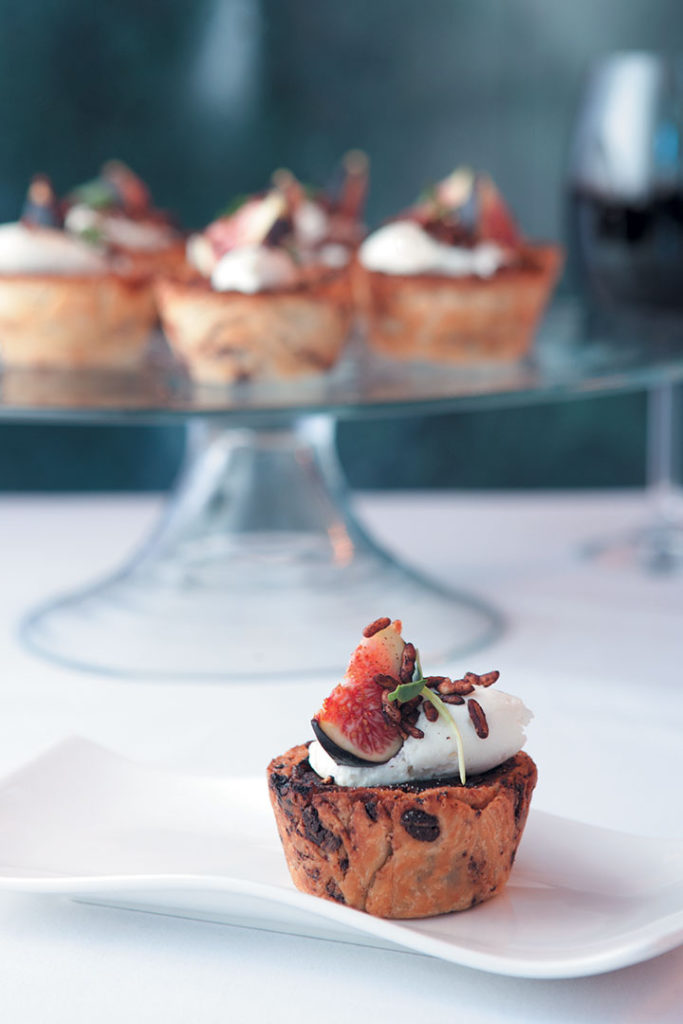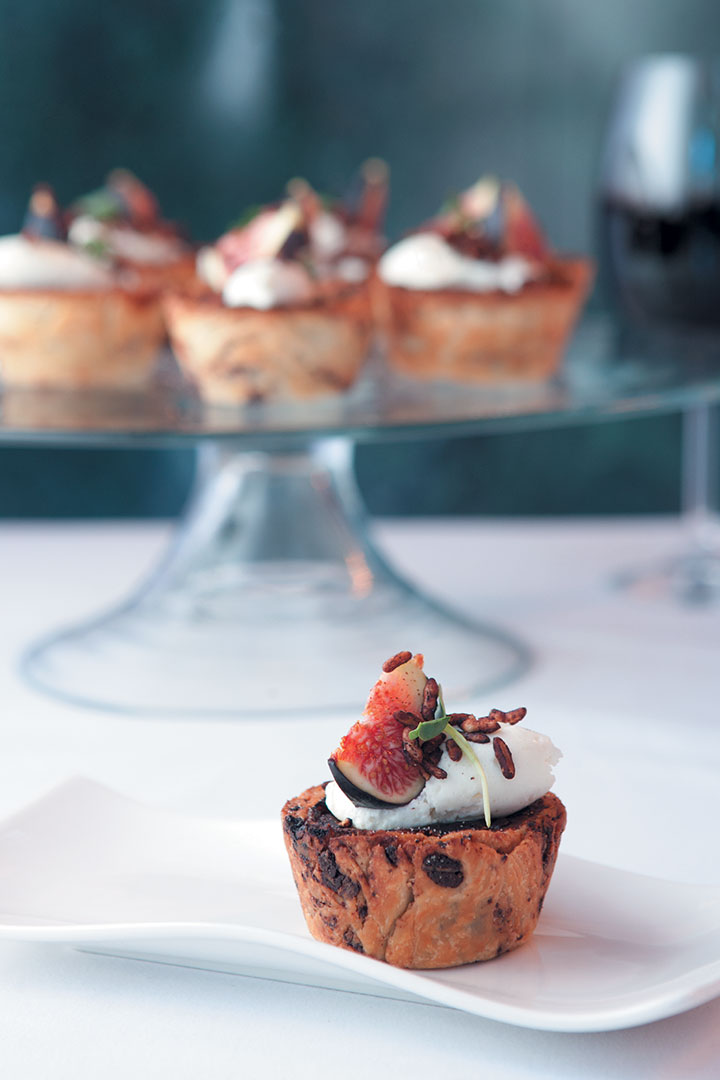A Portuguese custard tart is an old favourite, so why not add something new to it? It’s brunch, so there’s chocolate puffed rice – we cooked rice in cocoa water, dehydrated and then fried it in really hot oil until crispy – but you can use Kellogg’s Coco Pops cereal. The chocolate flavour is a twist on the traditional vanilla custard. This pastry is a challenge to make, so take this on onlyif you have some time on your hands!
PAIR WITH I love pasteis de nata and a natural pairing would be a seductive Moscatel de Setubal, from the Setúbalpeninsula of Portugal. Or – South Africa produces world-class fortified wine – Upington’s Orange River Cellars white or red Muscadel, served chilled, is one of our best-kept secrets.
Chocolate pasteis de nata by Chef Alfred Henry
Ingredients
DOUGH
- 330g cake flour + extra, to dust
- 1,25ml (¼ tsp) sea salt
- 250ml (1 cup) water
- 250g unsalted butter, softened
- 35g dark chocolate, grated
CUSTARD
- 45ml (3 tbsp) cake flour
- 10ml (2 tsp) cocoa powder
- 310ml (1¼ cups) milk
- 285g sugar
- 1 cinnamon quill
- 160ml (4 tbsp) water
- 80g dark chocolate
- 2,5ml (½ tsp) vanilla extract
- 6 large egg yolks, whisked
TO DECORATE
- freshly whipped cream
- fresh fig quarters
- icing sugar, to dust
- chocolate popped rice
- microherbs, to garnish (optional)
Instructions
For the dough, in a mixer fitted with a dough hook, mix the 330g cake flour, salt, and water until a soft, pliable dough forms.
Making this dough requires rolling and folding, similar to the method for making puff pastry from scratch. The aim is to achieve pastry that is light and layered with butter. Dust a clean work surface with the extra flour. Flatten the dough into a 15cm square, using a pastry scraper. Dust the dough with a little flour, cover with a clean tea towel and allow to rest, 15 minutes. Roll the dough out into a 45cm square, making sure the dough does not stick to the surface.
Brush the excess flour off the top of the dough and, using a small offset spatula, dot 1/3 butter over a 2/3 portion of the dough, then spread the soft butter leaving a 2,5cm plain border around the edge of the dough.
Neatly fold the unbuttered 1/3 of the dough over the buttered dough. Brush off any excess flour, then fold over the other 1/3 of the buttered dough. Starting from the top, pat down the dough with your hand to release any air bubbles and then pinch the edges of the dough to seal. Brush off any excess flour. Turn the dough 90° to the left, so the fold is facing you. Lift the dough and dust the work surface. Once again, roll it out to a 45cm square, then dot the left of the dough with _ of the butter and spread it over the dough.
Fold the dough as directed in step 4. For the last rolling, turn the dough 90° to the left and roll out the dough to a 55cm x 45cm rectangle, the shorter side facing you. Spread the remaining butter over the entire surface of the dough.
Sprinkle over the 35g grated dark chocolate to cover the butter on the dough’s surface.
Roll the dough into a Swiss roll, using the edge closest to you as a starting point. Make sure it forms a tight roll. Wrap in cling film and refrigerate to allow the butter to set and the dough to relax, overnight or for a minimum of 2 hours.
For the custard, whisk 45ml (3 tbsp) cake flour, cocoa powder and 60ml (4 tbsp) of the milk until well combined in a bowl.
Bring the sugar, cinnamon quill and water to a boil in a small saucepan. Cook until a sugar thermometer registers 100°C, taking care not to stir the mixture,as this will cause crystallisation.
In another small saucepan, heat the remaining milk. Once heated, add the 80g chocolate and melt. Whisk the chocolate milk into the flour mixture.
Remove the cinnamon quill from the sugar syrup and pour the syrup into the chocolate milk and flour mixture in a thick stream, whisking briskly. Add the vanilla and stir, 1 minute, until very warm but not hot. Whisk in the yolks, strain the mixture into a bowl, cover with cling film and set aside. The custard should have a thin consistency.
To assemble and bake the pasteis, heat the oven to 180°C. Remove a pastry log from the fridge and roll it back and forth on a lightly floured surface, until about 2,5cm in diameter and 40cm long. Cut into 2cm pieces. Place 1 piece of pastry dough, cut-side down, in each cup of a non-stick 12-cup mini muffin tin. Allow the dough pieces to soften completely before you continue to the next step.
Dip your thumbs in a little water, then straight down into the middle of the dough spiral. Flatten it against the bottom of the cup to a thickness of about 0,5cm, then smooth the dough up the sides and create a raised lip just above the tin’s edge. The pastry sides should be thinner than the bottoms of the bases.
Fill each pastry cup ¾ full with the custard. Bake the pasteis until the edges of the dough are crisp and brown, about 20 minutes.
Remove from oven and allow the pasteis to cool in the tin, a few minutes. Transfer the tin to a wire rack and cool down to room temperature.
Decorate the pasteis de nata with the freshly whipped cream (this can be piped or quenelled) and then add the fresh fig quarters. Lightly dust with a little icing sugar. Lastly, sprinkle with the chocolate popped rice and serve. Garnish with microherbs, if desired.
Notes
The pastry is a key part of the pasteis de nata. The chocolate pieces shouldn’t be bigger than finely grated powder or the custard filling will leak through the pastry.



